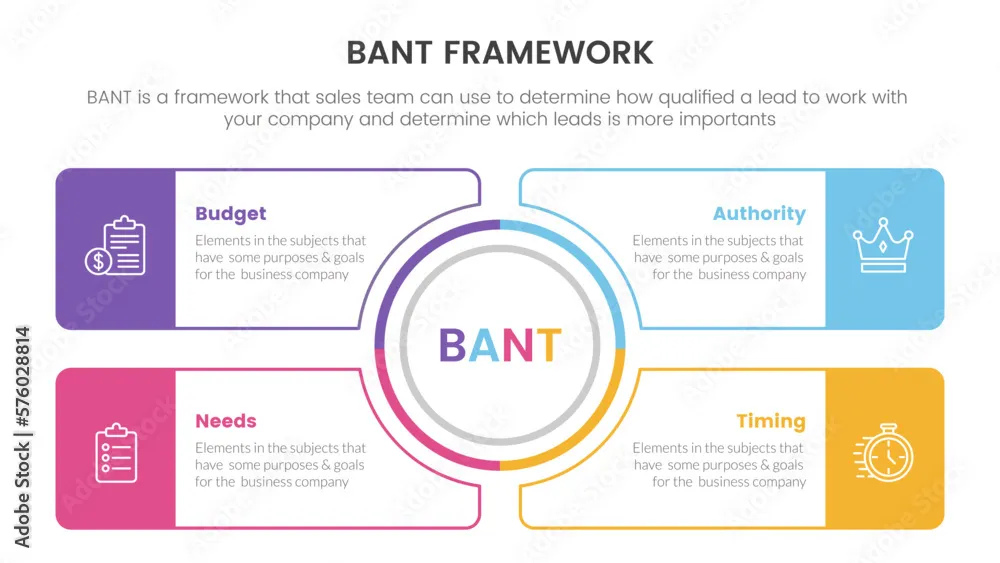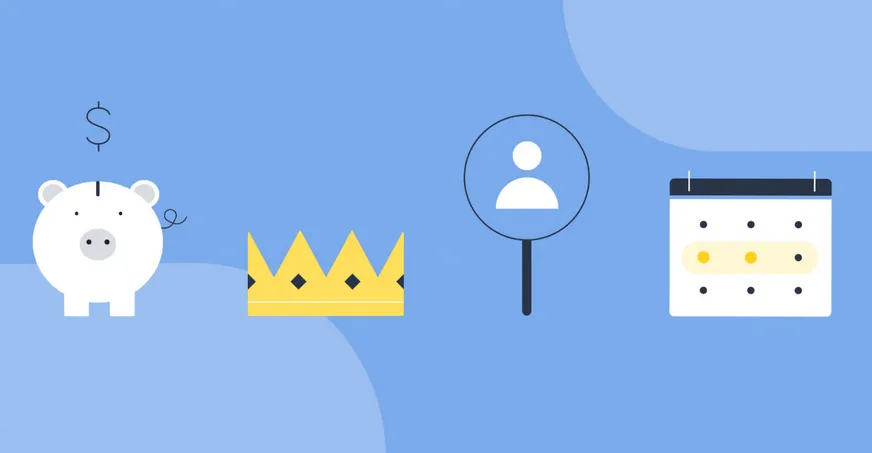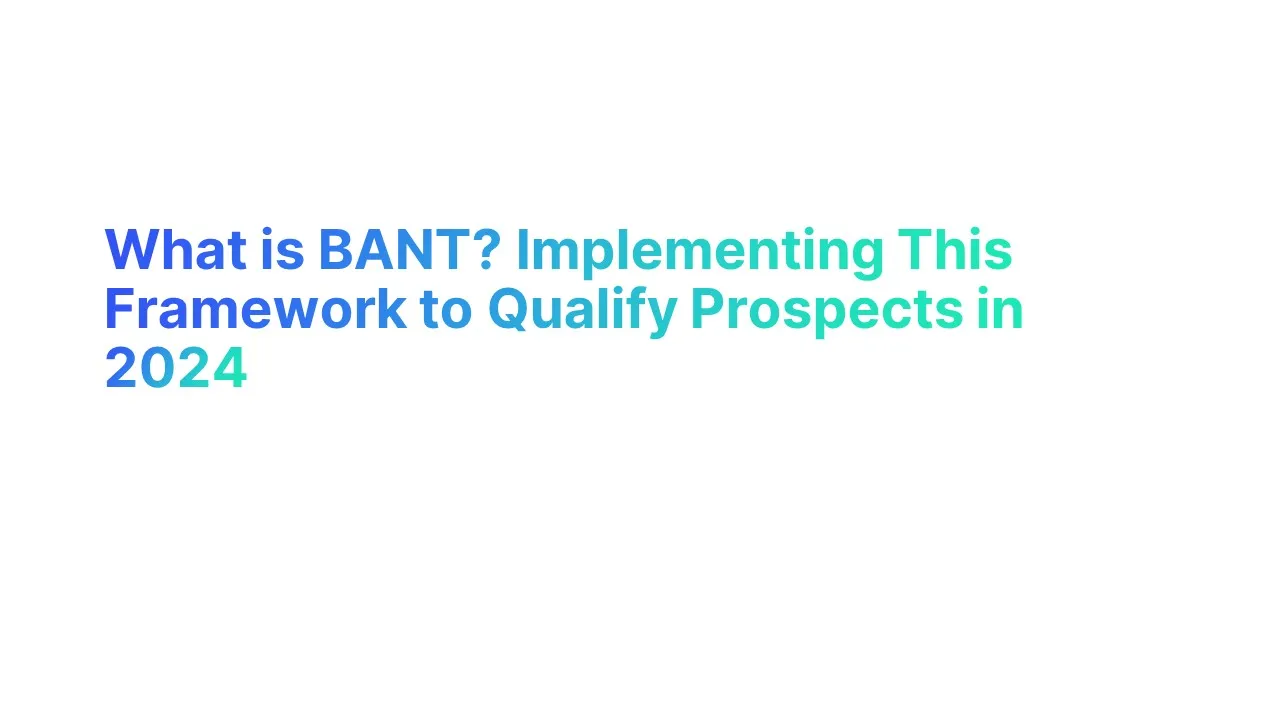What is BANT?

BANT is a renowned sales qualification framework that is a systematic and strategic approach to lead qualification, widely used by sales teams to optimize the sales cycle and enhance efficiency.
BANT stands for Budget, Authority, Need, and Timing—four crucial elements that help determine whether a prospect is a good fit for a product or service
BANT helps in:
- Efficient Lead Prioritization: By evaluating prospects against the BANT criteria, sales teams can focus on the most viable leads, optimizing resource allocation and increasing conversion rates.
- Improved Sales Communication: BANT helps tailor sales pitches and communications to match the specific circumstances of each prospect, enhancing the relevance and effectiveness of sales interactions.
- Better Resource Allocation: Focusing on qualified leads ensures efficient use of time and effort, boosting productivity and ROI.
- Clear Metrics for Success: BANT provides measurable criteria for lead qualification, aiding in setting realistic goals and tracking performance.
- Adaptability Across Industries: While rooted in B2B sales, BANT is versatile enough to be adapted for various industries, enhancing its utility across different sales scenarios.
BANT Methodology & Framework

Let's explore each component of the framework integral to the BANT lead qualification process in more detail
1. Budget
The first component, Budget, involves determining whether the prospective customer has the financial resources available to purchase the product or service.
Understanding a prospect’s budget early in the sales process helps to ensure that sales efforts are targeted appropriately. This step is crucial to avoid spending time on leads that cannot afford the solution being offered.
Budget Questions
1. "What is your budget for this project?"
2. "Have you already established a budget for this type of purchase, or are we setting it together today?"
3. "Can you walk me through your budget approval process?"
4. "What financial goals are you aiming to achieve with this solution?"
5. "Who else needs to be involved in the budget discussion for this project?"
6. "How does this investment fit into your current financial planning?"
7. "What are your top fiscal priorities this year, and how does this purchase align with them?"
8. "What budget constraints should we consider when proposing a solution?"
9. "If we prove the ROI of our solution, how would that impact your budget considerations?"
10. "Is there a future budget cycle we should be aiming for with this proposal?"
2. Authority
Authority checks whether the person you're speaking to has the power to make the purchasing decision, or if there is someone else whose approval is necessary.
This helps in identifying the decision-makers within an organization, which is essential for streamlining the sales process and focusing efforts on influencing the right individuals.
Authority Questions
1. "Who will make the final decision on this purchase?"
2. "Can you describe the decision-making process for purchases like this?"
3. "Who else is involved in the decision-making process for this type of investment?"
4. "What is your role in the decision-making process?"
5. "Are there any other departments or key individuals that need to be consulted before making a decision?"
6. "How do you typically present potential solutions to the decision-makers?"
7. "What challenges have you faced in the past with getting projects approved?"
8. "Who are the stakeholders involved in this decision, and what are their main concerns?"
9. "What does the approval process look like and how long does it usually take?"
10. "Do you foresee any obstacles in the approval process for this project?"
3. Need
This element assesses whether the prospect has a need that the product or service can fulfill. Understanding the customer’s needs is vital to effectively aligning the product's benefits with those needs. This ensures that the sales pitch addresses actual pain points, increasing the likelihood of a sale.
Need Questions
1. "What are the main challenges you are facing that prompted you to look for a solution?"
2. "Can you describe the problems you need this solution to solve?"
3. "What features are most important to you in a solution?"
4. "How do you measure success for the project you're considering?"
5. "What are your top priorities for this purchase?"
6. "What consequences will you face if these needs are not addressed?"
7. "How has the lack of a solution affected your business so far?"
8. "What solutions have you tried in the past, and why didn’t they work?"
9. "Are there any capabilities you wish your current solution had?"
10. "What is your ideal outcome from implementing a new solution?"
4. Timing
Timing determines the urgency of the need or the timeline by which the prospect aims to implement a solution. Knowing when a prospect plans to make a decision helps prioritize the lead and tailor the sales approach to fit their timeline.
Timing Questions
1. "What is your timeline for implementing a new solution?"
2. "By when do you need to have this solution in place?"
3. "Are there any events or deadlines driving your timeline for this purchase?"
4. "How urgent is this need?"
5. "What steps remain before you can make a decision?"
6. "Is there a specific date when you need to start seeing results from this solution?"
7. "What does your decision-making timeline look like?"
8. "Are there any upcoming projects or initiatives that might affect this timeline?"
9. "How does this timeline align with your budgetary cycles?"
10. "What are the consequences of delaying this decision?"

How Does the BANT Process Work

Let’s explore the step-by-step workflow of how the BANT process operates in a sales environment:
Step 1: Preparation and Initial Research
Before engaging directly with a prospect, sales professionals should prepare by gathering as much background information as possible. This can include:
- Researching the prospect’s company to understand its business model, market position, and financial health.
- Utilizing CRM data to review any previous interactions that could inform current opportunities and challenges.
- Planning questions that align with the BANT criteria to efficiently guide the conversation.
Step 2: Engaging the Prospect
The initial contact with a prospect is critical in setting the tone for the relationship. This step involves:
1. Introducing the value proposition of the product or service succinctly and compellingly.
2. Starting the BANT qualification by subtly integrating relevant questions into the conversation:
- Budget: "Can you share insights into your budget allocation for this type of solution?"
- Authority: "Who else is involved in the decision-making process for this type of purchase?"
- Need: "What are the key challenges you are looking to solve with this solution?"
- Timing: "What is your timeline for implementing a new solution?"
Step 3: Deep Dive into BANT Criteria
Once initial contact is established, the sales rep delves deeper into each BANT category to thoroughly qualify the lead:
- Budget Assessment: Understand not only if the prospect has the budget but whether that budget aligns with the pricing tiers of the product or service. This may involve discussing potential ROI and exploring different pricing models.
- Authority Mapping: Identify all decision-makers and influencers in the purchasing process. This could require setting up additional meetings with higher-level executives or other key stakeholders.
- Need Analysis: Conduct a detailed exploration of the prospect’s specific needs and pain points. This includes demonstrating how features of the product can uniquely address these issues.
- Timing Confirmation: Clarify the urgency of the prospect’s need. Understanding the buying timeline helps prioritize the prospect in the sales pipeline and tailor the sales approach accordingly.
Step 4: Tailoring the Pitch
Based on the information gathered through the BANT process, the sales pitch can be customized to address the specific budget constraints, authority dynamics, needs, and timing identified:
- Crafting proposals that meet the budget limitations and highlight value.
- Addressing the concerns and interests of all decision-makers involved.
- Focusing on solutions that directly resolve identified needs.
- Aligning delivery and implementation timelines with the prospect’s schedule.
Step 5: Follow-Up and Close by Your Sales Teams
Effective follow-up is crucial to maintaining momentum and closing the sale:
- Regularly update the prospect on any new developments or additional value propositions.
- Address any new issues or changes in the prospect's situation as they arise.
- Move towards closing the deal by reiterating the alignment of the product with the prospect’s BANT qualifications.
How to Implement the BANT Sales Framework

Here’s a step-by-step guide to implementing the BANT framework:
Step 1: Train Your Sales Team
Begin by educating your sales team on the BANT framework. This includes understanding the importance of each element—Budget, Authority, Need, and Timing—and how these factors influence the sales process.
Use scenarios that involve sales and marketing teams and decision makers to practice identifying BANT criteria through simulated sales calls and meetings.
Step 2: Integrate BANT into Your Sales Processes By Your Sales Reps
Incorporate BANT questions into sales scripts and checklists to ensure consistency across all interactions.
For example, include questions to uncover economic buyer information and sales qualification framework details.
Modify your CRM system to include fields for tracking BANT information such as prospect's budget, decision process, and prospect's timeline.
This ensures that all relevant data is captured and can be easily accessed.
Step 3: Qualify Leads Using BANT
During the first interaction with a prospect, use BANT to guide your questioning. Start by discussing the sales process and lead qualification process, and ask about their purchasing decision timeline to assess Timing.
In follow-up communications, delve deeper into each BANT component. For instance, confirm the economic buyer to address Authority, and discuss sales qualification needs to understand their specific requirements.
Step 4: Align BANT with Marketing Efforts
Ensure that your marketing and sales materials emphasize points that resonate with the BANT criteria.
For example, include content that speaks to the "lead generation" needs of prospects and outlines the efficiency of the buying process.
Adjust your lead scoring model to prioritize leads based on how well they score across the BANT criteria. This can help focus efforts on leads that are most likely to convert.
Step 5: Monitor and Refine the Implementation
Conduct regular reviews with your sales and marketing teams to discuss how effectively the BANT framework is being used and what improvements can be made.
This might involve reassessing the questions used to determine sales qualification or refining the CRM inputs for better data on sales cycles and qualified leads.
Create a feedback loop where sales reps can provide insights from their sales experiences regarding the practical applications of BANT, such as challenges with identifying the ultimate decision maker or understanding the prospect's expected ROI.
Step 6: Leverage BANT for Strategic Decisions
Use insights gained from BANT to make informed decisions about where to allocate resources most effectively.
For example, understanding the prospect's budget and purchasing power can help prioritize high-value clients.
Based on BANT data, adjust your sales strategies to better target leads that meet the BANT criteria, focusing on those with immediate sales qualification needs and confirmed budget availability.
DOs and DONTs of Using BANT Sales Qualification Framework

Here’s a guide on the DOs and DONTs of using the BANT framework to ensure your sales team maximizes its potential benefits.
DOs of Using BANT
Start with a clear understanding of each component:
- Budget: Confirm the prospect has the financial capacity for the purchase. Understanding the budget early helps tailor the sales pitch to match the prospect’s financial reality.
- Authority: Ensure you are speaking with the decision-maker. Time spent with non-decision-makers can lead to delays and miscommunication.
- Need: Identify and understand the prospect's primary challenges. This ensures the solution offered directly addresses their pain points, increasing the likelihood of a sale.
- Timing: Determine the prospect’s timeline for purchasing. Knowing the timeline helps prioritize the lead and tailor the sales efforts accordingly.
Integrate BANT smoothly into conversation:
- Use natural dialogue to uncover BANT criteria without making the prospect feel interrogated.
- Frame questions in a way that they add value to the conversation, showing that you are interested in understanding and meeting the prospect’s needs.
Use BANT to prioritize leads effectively:
- Score leads based on how well they meet BANT criteria, focusing more resources on those with the highest scores.
- This strategic focus increases efficiency and enhances the potential for closing deals.
DONTs of Using BANT
Avoid relying solely on BANT for every sale:
- BANT is a starting point, not the entire sales strategy. Some scenarios require flexibility, especially in complex sales cycles involving multiple stakeholders or in industries where long-term relationships lead to sales.
Do not use BANT as a checklist:
- Avoid ticking off BANT elements without considering the broader context of the prospect's situation. Each element should inform a deeper understanding and strategy adjustment, not just qualify or disqualify a lead.
Never assume all criteria are equally important:
- Weigh each component of BANT according to its importance in a specific sale. For instance, in some cases, a strong need might outweigh a less immediate timing.
- Understanding which elements are deal-breakers and which can be negotiated is crucial.
Do not ignore the flexibility of budget discussions:
- While confirming the budget, be open to discussions that might lead to upselling or downselling based on the prospect's needs.
- Sometimes, initial budget constraints can be overcome with the right value proposition or payment terms.
Implementing BANT Effectively
To ensure the BANT framework benefits your sales process, integrate it with CRM systems and ongoing training:
- Train sales teams regularly on effective questioning techniques and active listening to accurately gauge BANT criteria.
- Update CRM fields to track BANT information clearly, making it accessible for all sales and marketing teams, thus allowing for better follow-up strategies and more personalized engagement in future interactions.
Comparing BANT with Other Sales Methodologies (e.g., MEDDIC, CHAMP)
Concluding Thoughts
In conclusion, the BANT framework remains an essential tool for qualifying leads effectively as we head into 2024. By focusing on Budget, Authority, Need, and Timing, sales teams can efficiently prioritize efforts, ensuring resources are allocated where they have the highest potential for returns. This strategic approach not only enhances productivity but also adapts seamlessly across various industries.
However, while use the BANT framework significantly aids in qualifying leads, it's important to integrate it with contemporary sales strategies to accommodate complex buyer journeys. This adaptation ensures BANT continues to provide value in a holistic sales strategy, helping teams to focus on the most promising prospects and thereby increasing ROI.
Further Reading
Further enhance your understanding of sales strategies with these insightful resources, each designed to expand your knowledge and improve your techniques.
- Exploring Effective Sales Lead Generation: Delve into our detailed guide on strategies for successful sales lead generation. Discover actionable insights to attract and convert quality leads.
- Understanding the Difference Between Sales and Marketing: Learn why distinguishing between sales and marketing is crucial for any business and how each contributes to overall success.
- Foundations of Lead Generation: Get a thorough breakdown of lead generation techniques and how they can be effectively implemented in your business strategy.
- Unlocking Success with Lead Generation: Discover outbound strategies that drive sales and enhance your lead generation efforts.
- What Does MQL Mean?: Understand the meaning of Marketing Qualified Lead (MQL) and how it fits into the sales funnel to optimize your marketing efforts.









